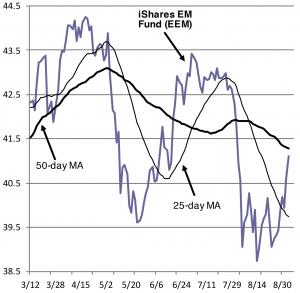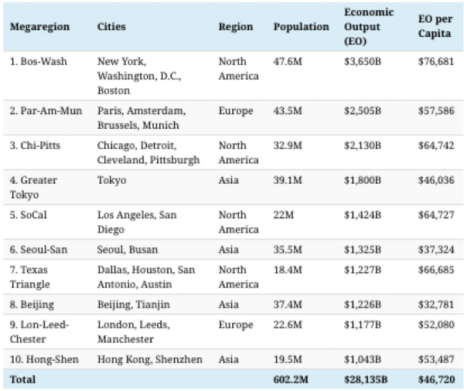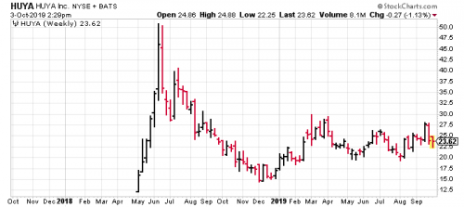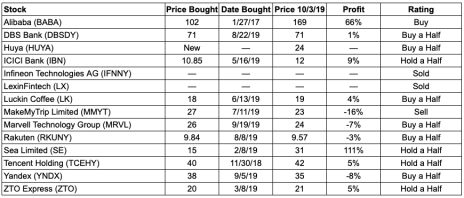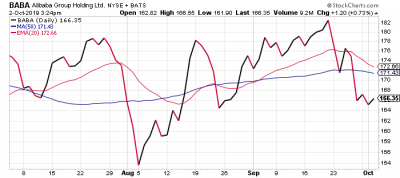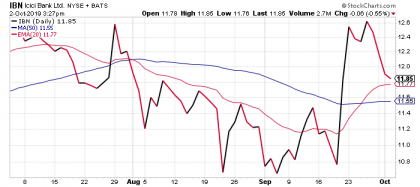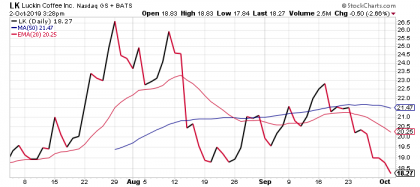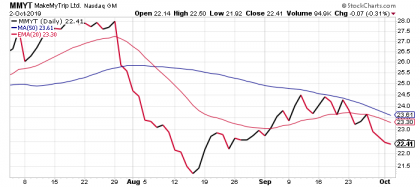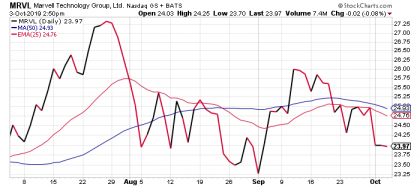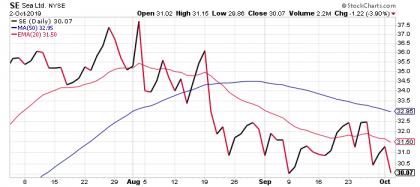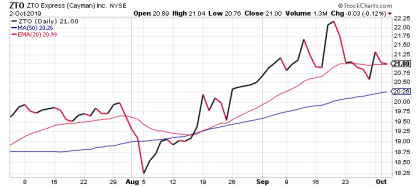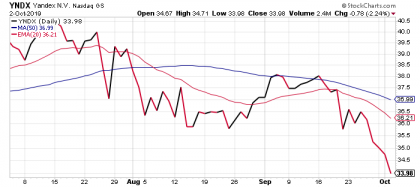Some weak economic numbers and political uncertainty about Hong Kong roiled markets a bit but emerging and international stocks rebounded a bit today. China stocks are getting some scrutiny in Washington amidst U.S.-China rivalry. Nevertheless, our new recommendation today is from the Middle Kingdom and is centered on a high growth theme that has a lot of momentum behind it.
Cabot Global Stocks Explorer 695
[premium_html_toc post_id="187765"]
Cabot Emerging Markets Timer
The Emerging Markets Timer is our disciplined method for staying on the right side of the emerging markets. The Timer is bullish when the index is above the lower of its two moving averages and that moving average is trending up.
Our Emerging Markets Timer has raced higher in recent days, putting it within striking distance of a new buy signal. You can see in the chart that the iShares EM Fund (EEM) held support in the 39 area for much of August, and recently, has spiked nicely above its lower (25-day) moving average. Now we need to see that 25-day line itself turn up to get a green light.
Examining the chart, the Timer could flash a green light early next week if EEM holds (or extends) its gains in the days ahead. We’ll be watching for it, but importantly, we don’t anticipate these signals—right now, the intermediate-term trend is effectively sideways, so you should still tread carefully.
While Markets Hit a Bump, Emerging Market Growth Continues
The portfolio currently has a 40% cash position cushioning us against recent market weakness but still allowing us the flexibility to take advantage of new opportunities.
A number of our stocks demonstrated relative strength during the last week and came out with some positive news. For example, Tencent’s Call of Duty Mobile attracted 20 million gamers within the first two days of its world debut.
Emerging markets (EEM), after a surge from late 2018 through the first quarter of 2019, have struggled a bit, trading just over 40.
Let me briefly summarize the update that went out to you early Monday morning regarding some media attention to Chinese stocks last week.
In the midst of Congress taking a more confrontational attitude towards China, Senator Marco Rubio has been advocating and has introduced legislation calling for stronger investment restraints and greater scrutiny for Chinese companies listed on U.S. exchanges as well as Chinese stocks in stock indexes and U.S. pension funds.
It goes without saying that the SEC should ensure that Chinese stocks and international stocks should meet the same transparency and disclosure standards of publicly traded U.S. stocks.
One issue is that some Chinese companies have apparently not been complying with PCAOB standards (Public Company Accounting Oversight Board). There are 156 Chinese companies, including at least 11 state-owned firms, listed on the three-largest U.S. exchanges - the NASDAQ, New York Stock Exchange and NYSE American - according to a report by the U.S.-China Economic and Security Review Commission.
What hit China stocks in particular last Friday were reports that the Trump Administration was discussing taking actions well beyond these disclosure and transparency concerns. This pushed Lexinfintech (LX) through our stop loss so it was removed from the portfolio on Monday morning.
This week the White House backed off a bit due to some pushback from Wall Street. This is consistent with an announcement that BlackRock is considering forming an expanded partnership with Tencent after Vanguard Group formed a joint venture earlier this year with Alibaba affiliate Ant Financial.
While keeping a sharp eye on this issue, I’ll continue to recommend private, high quality Chinese companies as we do today with our new Huya buy recommendation.
All this also highlights the need for a diversified portfolio and attention to managing risk.
Mega Regions Drive Global Growth
While it’s common to look at the world by the size of a country’s economy relative to others, it is more interesting and helpful to think of the economy that is driven by growth clusters that taken together account for a sizable amount of world economic output.
Take a look at the below list of the largest ten of these “mega regions” based on data from Oxford Economics.
The above powerhouses as a group bring in over $28 trillion in economic output each year, which is about 50% higher than America’s total economy.
It’s interesting that the Boston-New York-Washington corridor leads the way with its strengths in information technology, finance, and professional services. For the United States, it might surprise you that the Chicago/Pittsburgh mega region ranks higher than Southern California/San Diego/Silicon Valley.
São Paulo, Brazil is the only city in the Southern Hemisphere to make the list. The city was once heavily reliant on manufacturing and trade, but the $780 billion city economy is now embracing its role as a nascent financial hub.
In the Far East, Asian mega regions combine for $8.7 trillion in total economic output. Of these, Greater Tokyo in Japan is the largest, while Shandong might be a name that some of you might not be familiar with. Located between Beijing and Shanghai, the coastal province houses extensive high-tech industrial and special export zones.
Today’s new recommendation is from this region and is standout in terms of growth at the sweet spot of young Chinese spending on low-ticket items. This is important since Chinese overall economic growth and spending are facing headwinds these days.
Featured Stock
New Recommendation: Huya (HUYA)
Huya is China’s leading e-sports platform and game-streaming brand and is rapidly expanding into other emerging markets.
Here are the major points behind this recommendation.
- China’s slowing economic growth rate will likely lead to further relaxing of restrictions on gaming in general and Beijing already seems to favor esports over video games not related to sports.
- Huya has a large, open pathway to grow beyond China in emerging markets. This is important since 72% of frequent e-sports viewers live outside of the U.S. and Europe and the company is expanding aggressively in Asia-Pacific and Lain America with the logistical support of Tencent.
- Brazil and South Korea look especially promising. The company also operates Nimo TV, a game live streaming platform primarily in Southeast Asia and Latin America.
- While still a relatively small company with a market cap of under $5 billion, Huya is backed by Tencent and has clean balance sheet with $1.3 billion in cash.
- Huya just posted a strong quarter with monthly users growing 57% year over-year to reach 144 million and revenue growth of 94%. In addition, gross margins improved slightly and sales and marketing expenses are only 6% of revenue. Esports is a high growth market with the global player base for e-sports projected to double in the next two years according to esports wizard.
- Huya has proven to be adept in forming local and national partnerships with companies, teams and stars, which is the key to success.
- Huya also seems to be in a better position than its main competitor DOYU, based on revenue and earnings. Revenue growth has been accelerating for Huya while decelerating for DOYU and Huya is the leader in the important and more profitable mobile segment.
- Huya, now trading just over 23, has over the last two months hit higher highs and higher lows and could break out around its March 2019 high of 30.
This is an aggressive, high growth China idea so I advise putting in place a 20% trailing stop loss and starting with a half position.
BUY A HALF
Huya (HUYA)
Building B-1
North Block of Wanda Plaza No. 79
Wanbo 2nd Road Panyu District
Guangzhou 511442
China
86 20 8212 0800
http://www.huya.com
Model Portfolio
Updates
Alibaba (BABA), trading just under 170, will very likely continue to dominate China e-commerce and its stock is valued attractively at about ten times expected 2020 earnings.
Baba had its investors day event this week and laid out some ambitious goals such as building out from current 730 million annual active users to over 1 billion users by the end of fiscal 2024.
Baba also plans to grow sales, which currently at $850 billion per year are larger than Amazon and Walmart combined, to $1.4 trillion by 2024.
Alibaba’s cloud unit AliCloud remains the dominant player in China with a 43% market share and its video-streaming website Youku saw 46% year-over-year growth in paying subscribers during the June quarter.
Alibaba’s digital finance subsidiary Ant Financial is also becoming a dominant force in finance through its digital payment platform Alipay.
The company’s e-commerce business lends itself well to a natural monopoly as Baba has over a 50% market share. Alibaba’s cloud infrastructure business also benefits from its scale and lower costs.
BABA can easily get back to the 200 level and beyond provided that trade tensions ease. I encourage you to buy a full position in this stock if you have not already done so.
BUY A FULL POSITION.
DBS Bank (DBSDY) shares held firm this week despite turmoil in global markets.
DBS is a high quality conservative play on Singapore and Southeast Asia financial services and comes with a 4.8% dividend yield.
It is the largest and strongest bank in Southeast Asia and the leading consumer bank in both Hong Kong and Singapore. Its tentacles reach out through 200 branches in 50 cities. DBS produces steady profit margins, revenue, and earnings and is also increasing market share in consumer and corporate banking.
Despite all of these strengths, DBS is trading at only eleven times trailing earnings. Any tangible improvements in the US-China relationship should get this stock moving.
BUY A HALF
ICICI Bank (IBN) shares didn’t do much this week after last week’s 19% surge as India’s banking sector got a boost from a tax cut aimed at igniting more growth in India’s economy.
IBN is a solid India play; there are still 191 million Indians without a bank account, which means a lot of potential new customers. This is a good entry point to take a stake in IBN if you have not yet done so.
HOLD A HALF.
LexinFintech (LX) shares fell below our 20% trailing stop loss last Friday so we moved this to a sell on Monday morning.
Luckin Coffee (LK) shares were up today but have clearly underperformed over the last month. No new news for this stock, which is trading just above our entry price. Keep in mind that Luckin is an aggressive stock that has only one quarter of operations under its belt since its IPO earlier this year.
Despite its breakneck pace of opening new stores and stands, its CFO has publicly stated it plans to be a breakeven by the end of next year. Its second quarter had high sales and marketing expenses, which can be dialed back in the future.
Luckin believes there is room for more than Starbucks in a market of 300 million plus middle class consumers. Its strategy to compete with Starbucks is a combination of quality, convenience and affordability with a price target of 50% of Starbucks. Most of its shops are set up for takeaway and delivery rather than the Starbucks model of a place to meet and work.
In addition to its core coffee, Luckin has added tea and just announced that it will be developing a joint venture to produce and distribute co-branded juices.
Luckin keeps expanding its fleet of stores, which grew 375% annually to 2,963 locations and it plans to eclipse Starbucks with 4,500 stores by the end of the year.
According to Iyiou’s estimate, Starbucks China sold 400 million cups in 2018, which implies only 311 cups per day per store. Luckin currently operates at 345 orders per store at the day level, an increase of 18% from a year ago and 41% from the previous quarter. Keep in mind that while Taiwan consumes 209 cups of coffee per person each year, China consumes only 6 cups of coffee per person.
If you have not invested in Luckin, which is an aggressive idea that won’t be posting profits for some time, I encourage you to do so up to a half position with a 20% trailing stop loss in place. BUY A HALF.
MakeMyTrip Limited (MMYT) shares were recently moved to hold against a backdrop of a softening India economy.
A play on India’s travel industry as well as digital payments and marketing,
MakeMyTrip has evolved into a leading travel company as India evolves into a digital marketplace by providing a comprehensive range of travel services.
The company has made key acquisitions and strategic partnerships and a key alliance is with Ctrip, China’s largest online travel group.
While I believe that MMYT offers attractive exposure to a high growth consumer market in India, I’m moving this to a sell based on its relative weakness. We will very likely come back to this stock down the road.
MOVE FROM HOLD A HALF TO SELL A HALF
Marvell Technology Group (MRVL), a recent addition to the portfolio and a player in 5G in what is known as smart devices, was off a bit this week.
Marvell is at the heart of web-enabled devices that collect, send and act on data using sensors, processors and other hardware to talk to each other.
The company’s embedded processors and products are cutting-edge and already generating multibillion-dollar annual sales. Marvell is headquartered in Bermuda with operations in the U.S., China, Taiwan, Japan, India, South Korea, Vietnam and several other countries.
New markets are emerging in which Marvel has a first-mover advantage such as virtual reality, drones, data integration and consumer and industrial robotics.
These are all huge markets giving Marvel a long runway of growth as it could hit $3.5 billion of sales next year with some analysts expecting $1.49 in earnings – up significantly over expected 2019 earnings.
Finally, although the stock is in an uptrend, it is still trading at just 2.3 times book value. I have high expectations for this stock and encourage you to start with a half position.
BUY A HALF
Rakuten (RKUNY) shares toped 10 early this week before pulling back a bit. If you haven’t yet bought shares, this would be a good time to buy a half position.
Rakuten is a well-diversified Japanese conglomerate with tentacles throughout Japan and has plenty of running room for international expansion. Its loyalty membership program is more than 100 million strong and it is Japan’s #1 Internet bank, #1 credit card and one of the country’s leading travel platforms.
The company’s core business is as an internet sales platform akin to Amazon. The company’s market share in Japan is about 25%. It is a growth conglomerate with multiple drivers and a sterling balance sheet with cash and short-term investments worth roughly $12.5 billion. After a 16% increase in revenue during its latest quarter, the stock is trading at just ten times trailing earnings, and offers an impressive 30% return on equity. BUY A HALF
Sea Limited (SE) shares have been treading water over the last month just above 30 after pulling back from a peak at 36 after a very strong run.
Sea, which owns e-commerce platform Shopee and has a license to distribute Tencent’s gaming services in Southeast Asia and Taiwan, reported its e-commerce revenue more than tripled in the April-June period versus the same period a year ago. Sea also raised $1.5 billion in capital this year.
We’ll wait for SEA to break out above what appears to be resistance around 32 to move the stock back to a buy. HOLD A HALF
Tencent’s (TCEHY) Call of Duty Mobile has attracted 20 million gamers within the first two days of its worldwide debut, a big boost for the company’s ambition of adapting top-tier titles with global name recognition for smartphones.
The Hong Kong market, trade turmoil and the inconsistent handling of gaming restrictions by Beijing have all weighed on shares. Its gaming business, which accounts for 30% of total revenue, was up only 8% but this a big improvement after three consecutive of negative comparisons.
Tencent has invested in over 700 companies in recent years and many of the most intriguing of these are in overseas entities. It is thought that between 30% and 40% of its investments are in non-Chinese companies.
We will wait for an uptrend to develop before moving this to a buy. HOLD A HALF
ZTO Express (ZTO) shares, which got a bump from its positive second quarter earnings, have demonstrated relative strength this week and are likely building a base and are close to a buy point. This should move the stock forward in line with its strong fundamentals.
Based in Shanghai, ZTO, known as the China Fed Ex, is one of the largest express delivery companies, not just in China but globally. It offers services to millions of traditional merchants, e-commerce sites, and online sellers using a proprietary tracking system, a state-of-the-art transportation management system, and more than 5,000 trucks, as well as hundreds of business partners. And ZTO serves foreign customers through partnerships with many international express delivery companies. I’m keeping this a hold for now. HOLD A HALF
Yandex (YNDX) announced this week the launching of a video streaming service aimed at rivaling Google’s YouTube that will allow users to publish videos on its personal recommendation platform Yandex Zen.
Yandex, trading at just 8 times forward earnings estimates, is overlooked by sophisticated investors and even then, is primarily viewed as only a search engine play that has cornered 57% of the Russian market.
The company is incorporated and based in the Netherlands but its core business is the online search. This core business is up 20% over the last year but I believe it has room to run and the market is not recognizing some key growth drivers such as Yandex Taxi, a food delivery service.
Yandex is not off to a great start in our portfolio but the stock was picked up for research coverage this week by Alfa Bank with an outperform rating and a price target of 48, implying 34% upside. BUY A HALF
Charts courtesy of StockCharts.com
The next Cabot Global Stocks Explorer issue will be published on October 17, 2019.
Cabot Wealth Network
Publishing independent investment advice since 1970.
CEO & Chief Investment Strategist: Timothy Lutts
President & Publisher: Ed Coburn
176 North Street, PO Box 2049, Salem, MA 01970 USA
800-326-8826 | support@cabotwealth.com | CabotWealth.com
Copyright © 2019. All rights reserved. Copying or electronic transmission of this information is a violation of copyright law. For the protection of our subscribers, copyright violations will result in immediate termination of all subscriptions without refund. No Conflicts: Cabot Wealth Network exists to serve you, our readers. We derive 100% of our revenue, or close to it, from selling subscriptions to its publications. Neither Cabot Wealth Network nor our employees are compensated in any way by the companies whose stocks we recommend or providers of associated financial services. Disclaimer: Sources of information are believed to be reliable but they are not guaranteed to be complete or error-free. Recommendations, opinions or suggestions are given with the understanding that subscribers acting on information assume all risks involved. Buy/Sell Recommendations: All recommendations are made in regular issues or email alerts or updates and posted on the private subscriber web page. Performance: The performance of this portfolio is determined using the midpoint of the high and low on the day following the recommendation. Cabot’s policy is to sell any stock that shows a loss of 20% in a bull market or 15% in a bear market from the original purchase price, calculated using the current closing price. Subscribers should apply loss limits based on their own personal purchase prices.

